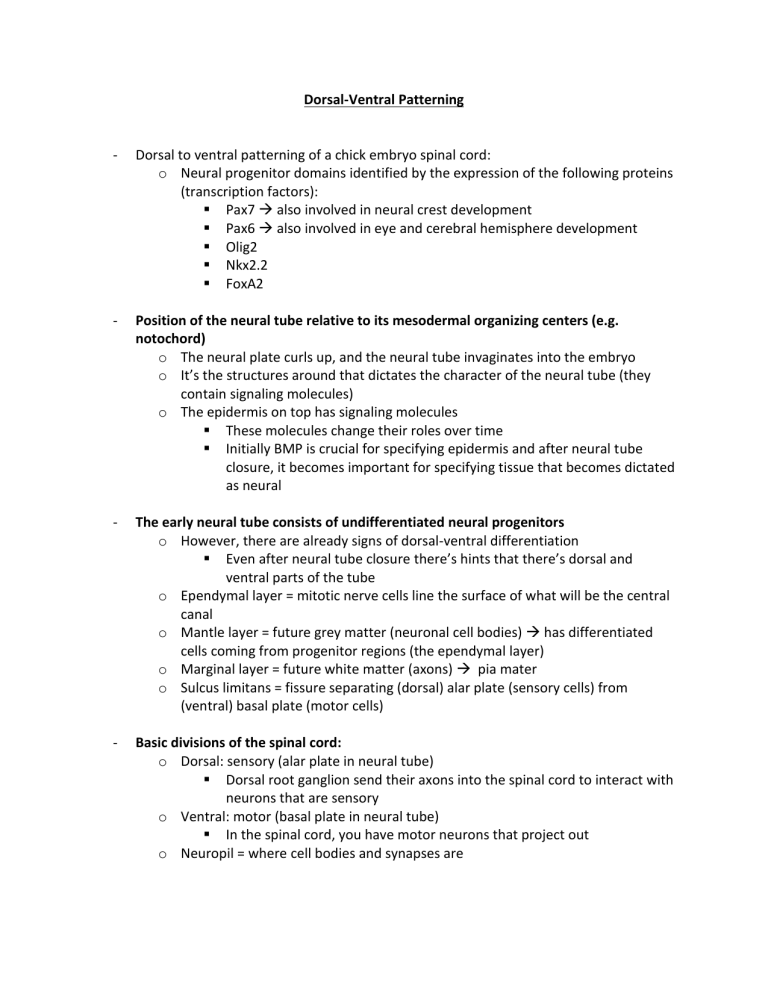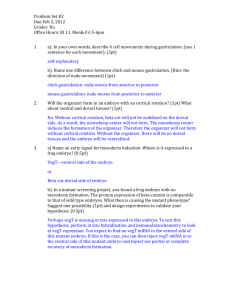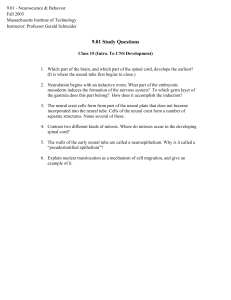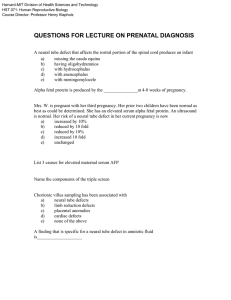
Dorsal-Ventral Patterning - Dorsal to ventral patterning of a chick embryo spinal cord: o Neural progenitor domains identified by the expression of the following proteins (transcription factors): Pax7 also involved in neural crest development Pax6 also involved in eye and cerebral hemisphere development Olig2 Nkx2.2 FoxA2 - Position of the neural tube relative to its mesodermal organizing centers (e.g. notochord) o The neural plate curls up, and the neural tube invaginates into the embryo o It’s the structures around that dictates the character of the neural tube (they contain signaling molecules) o The epidermis on top has signaling molecules These molecules change their roles over time Initially BMP is crucial for specifying epidermis and after neural tube closure, it becomes important for specifying tissue that becomes dictated as neural - The early neural tube consists of undifferentiated neural progenitors o However, there are already signs of dorsal-ventral differentiation Even after neural tube closure there’s hints that there’s dorsal and ventral parts of the tube o Ependymal layer = mitotic nerve cells line the surface of what will be the central canal o Mantle layer = future grey matter (neuronal cell bodies) has differentiated cells coming from progenitor regions (the ependymal layer) o Marginal layer = future white matter (axons) pia mater o Sulcus limitans = fissure separating (dorsal) alar plate (sensory cells) from (ventral) basal plate (motor cells) - Basic divisions of the spinal cord: o Dorsal: sensory (alar plate in neural tube) Dorsal root ganglion send their axons into the spinal cord to interact with neurons that are sensory o Ventral: motor (basal plate in neural tube) In the spinal cord, you have motor neurons that project out o Neuropil = where cell bodies and synapses are o Pseudounipolar neurons: don’t have dendrites. Have one axon that comes out of it and during development, that axon grows to the periphery into the spinal cord. Here it comes in contact with second order sensory neurons. - Dorsal-ventral differentiation of neural tube depends on the notochord o These experiments identified the notochord as an organizer: the notochord secretes a signal that triggers formation of neural tube and determines which part takes on ventral identity within the neural tube o LOF and GOF experiments show that the notochord is necessary and sufficient for development of floor plate and motoneurons o The notochord secretes diffusible signaling molecules that influences tissues surrounding it (it’s a morphogen) - Sonic hedgehog (SHH): a secreted protein o Drosophila homolog, hedgehog, originally cloned from stubby surface hairs of mutant Drosophila that looked like a “hedgehog” o Shh (mammalian equivalent) appears first in notochord, then in floorplate: the notochord influences floorplate (which in turn becomes a signaling center, also expressing SHH) SHH is expressed at the right place and right time to govern floor plate development The floor plate and roof plate are specialized glial cells - Cell culture experiments confirmed Shh as a ventralizing factor o Explants of intermediate neural tube express characteristic transcription factors o Intermediate neural tube explants express a combination of dorsal markers and intermediate/precursor markers o The neural tube is divided into 3 regions and the intermediate part of the tube differentiates last So, you use intermediate explants for experiments take the intermediate tube and stick it in a dish, it doesn’t differentiate but contains dorsal and intermediate precursor markers If you add candidate diffusible signaling molecules, the explant starts to express ventral markers Shh gives the neural tube its ventral character o Pharmacologically, can put a Shh antagonist in Get cyclopia (1 eye) Shh is also important for patterning anterior axis tells the eye field and cerebral hemispheres to separate - SHH protein is sufficient to induce expression of ventral portion of neural tube o Shh is a morphogen, which is a molecule that diffuses to form a concentration gradient that has differential effects on cells of the neural tube depending on its concentration o If you take out the intermediate explant and put it in a dish, it will express dorsal and intermediate genes If you add SHH in a concentration dependent manner, the explant will express ventral genes It is sufficient to induce expression of ventral factors and sufficient to suppress expression of dorsal factors - A gradient of Shh gene expression (thus SHH protein) determines cell fate in the ventral neural tube o Discrete and different neuronal populations arise from spatially separated progenitor domains o Cell fate is determined by the concentration of SHH at each dorsal-ventral position You get nice, precise borders between regions of progenitor zones in the presence of a smooth gradient of SHH - SHH gradient governs the expression of transcription factors o Distinct domains are defined by expression of a characteristic combination of genes o Class I transcription factors (e.g. pax6, pax7) are repressed by Shh (this is why dorsal/intermediate markers are expressed in explants of intermediate neural tube) o Class II transcription factors (e.g. Nkx2.2) are activated by Shh o Class I and class II transcription factors cross-repress each other to form boundaries o From an initially graded signaling molecule, you get a nice border between TFs because of differential effects of SHH on those TFs. There’s cross repression between TFs and because of differential cell adhesion between more dorsal and more ventral cells - Shh signaling (in vertebrates) o In the absence of Shh, transmembrane receptor Patched (PTCH1) inhibits Smoothened (SMO, a G-coupled receptor protein) SHH binds to PTCH1 and alleviates inhibition of SMO Signal is transduced to the nucleus by the GLI family of Zinc-finger transcription factors (GLi1, GLi2, GLi3). Activated GLI in the nucleus controls the transcription of hedgehog target genes PTCH1 has also been reported to repress transcription of hedgehog target genes through a mechanism independent of SMO o In the absence of SHH, there’s 2 transmembrane receptor molecules (Patched and Smoothened) When there’s no SHH, Patched inhibits Smoothened When SHH binds, Patched can no longer inhibit Smoothened, activating GLI proteins Promotes Class II and inhibits Class I - Generating dorsal character is dependent on BMP and Wnt signaling: BMP first in epidermis, then roof plate; Wnt induced by BMPs and expressed in the dorsal neural tube o In the dorsal part, BMP is expressed by epidermis. Later, BMP induces BMP expression in the roof plate. o By doing intermediate explants, in a concentration dependent manner, BMP4 induces expression of TFs with more dorsal character BMP is added to a dish on top of SHH at increasing concentration of SHH, you get high ventral character. Add BMPs on top of that, and you get more dorsal character. - BMPs and SHH antagonize one another to establish dorsal-ventral fate o Adding BMPs with SHH prevents expression of ventral markers o If BMP effects are dominant, and the neural tube is exposed to both BMPs and Shh, then why does ventral character emerge at all? Because spatial relationships between morphogen sources and affected cells: BMP diffusion from the roof plate creates a gradient in the dorsal neural tube The ventral part of the spinal cord is exposed to ventral signaling center (the floor plate) and the dorsal part is exposed to the roof plate (like SHH) BMPs regulate transcription factor expression to govern dorsalventral fate: Dorsal genes are activated by BMPs Ventral genes are inhibited by BMPs Dorsal cell types require higher concentration of BMPs - Contributions of molecules to dorsal-ventral fate change with time o Early FGF expression may prevent BMP from exerting effects on the neural tube until SHH is expressed because BMP would promote Class I TFs o Then you get expression of the enzyme that’s responsible for RA synthesis RALDH2 = retinaldehyde dehydrogenase 2 is an enzyme that catalyzes synthesis of retinoic acid (RA) from retinaldehyde o FGF8 is expressed in the mesoderm and some of the neural plate Then RALDH2 in the somites At the same time, you get SHH in the notochord and floor plate The mere presence of these diffusible signaling molecules around the neural tube means they have a role in organizing layers within the spinal cord - RA and FGF also function in dorsal-ventral patterning o Class I = dorsal; Class II = ventral o FGF2 strongly inhibits expression of Class I transcription factors (without inducing Class II) it may thus prevent BMPs from exerting effects on more ventral neural tube until SHH is expressed o RA promotes expression of Class I transcription factors that are characteristic of intermediate neural tube o RA and FGF2 originate from adjacent mesodermal tissue - A special case for motoneurons: o Early on (before neural tube closure) Shh induces the expression of the class II TF Nkx6 and something else induces the Class I TF Pax6 (Shh inhibits Class I TF expression): both are required for eventual expression of Olig2 RA increases the expression of Pax6 o These (Pax6 and Nkx6) do so by repressing expression of Dbx (more dorsally) and Nkx2.2 more ventrally – these inhibit Olig2 expression (and vice versa). That is, Olig2 expression emerges at least in part because of de-repression. Olig2 and Irx3 then cross-repress each other. o This means some other signal might activate Olig2 expression o Pax6 and Nkx are both needed for motoneuron expression - GOF experiments: RA o Control intermediate explants express Pax6 and Irx3 o FGF2 suppresses Pax6/Irx3 expression (these may be expressed by default in the neural tube: Pax6 is also inhibited by BMPs) o Addition of RA increases Pax6 and Irx3 expression o Addition of Hedgehog alone decreases Pax6 and Irx3 expression but induces Nkx6 expression and some Nkx2.2. Not characteristic of MN progenitors since they lack Pax6. o FGF2 also suppresses Hh-induced class II TFs o Exposure of the neural tube to RA (somites) suggests it might participate in MN specification: adding RA and Hh together generate explants that look more like MN progenitors ought to o M, N, O, P are not characteristic of motor neuron progenitors because they are not expressing Pax6 If you have Hh and RA together, they look more like motoneuron progenitors - LOF experiments – RA required for high-level Class I TF expression o Chick neural plate electroporated with non-functional (dominant negative) retinoic acid receptor RAR403 along with EGFP (to identify which cells were successfully electroporated) o After neural tube closure Pax6/Irx3 is expressed at lower levels (but is still there) in electroporated cells. Nkx6 and Nkx2.2 (class II TFs) relatively unaffected (slight expansion of territory due to loss of repression by Class I TFs). Therefore, RA is required for high-level Class I TF expression did nothing for Class II o When RA signaling is disrupted, there is decreased expression of Pax6 and Irx3 They’re still there but decreased - - After Pax6/Nkx6 expression in pMN domain, Olig2 expression begins o Here (figure F&G) explants from chicks previously electroporated with RAR403 (in which Pax6 is still expressed but at lower levels), when exposed to Hh (which induces Nkx6 expression), do not express Olig2 at all in the electroporated cells. o Figure H shows the same result in vivo, in which the neural tube is exposed to Shh from the notochord and floorplate o The loss of Olig2 expression is greater than that which would be expected by lower (but still there) Pax6 expression. This means that RA is directly required for Olig2 induction in Pax6/Nkx6-positive cells Following Olig2 expression, motoneurons differentiate and express several characteristic markers. Olig2 also acts as a transcriptional repressor, meaning that it allows these other markers to be expressed o In this experiment, chicks were electroporated with RAR403 (this manipulation prevents Olig2 expression). To avoid this, and to ask if RA is involved in MN differentiation, Olig2 expression was forced in the same cells receiving RAR403. o The loss of MN differentiation markers indicates that RA functions again in differentiation of Olig2-positive progenitors into mature motoneurons. o Note that Ngn2 is expressed in numerous types of ventral neurons (not just motoneurons), and so RA may be important for their specification as well o Olig2 cells exit from cell cycle, migrates into the mantle zone, and get expression of TF that are characteristic of motoneurons (Mnx, Isl1/2, and Lim3) - SUMMARY: o FGFs suppress Class I and II TFs to allow continued growth of the neural plate. Shh then induces Class II TFs like Nkx6 while RA promotes high-level Pax6 expression. These exclude Dbx and Nkx2.2 expression from the pMN domain, allowing for (but not directly activating) Olig2 expression. RA does activate Olig2 expression. Later, RA activates motoneuronal (and pan-neuronal marker) expression in Olig2-positive cells. o FGFs suppress Class I and II expression, maintaining the neural plate in an undifferentiated state FGF expression is shut off when Shh and RA signaling starts o Describe similarities between neural induction and expression of pMN domain: BMP signaling = brakes and FGF = accelerator Brakes = Class I and II and accelerator = RA - What are the roles of FGF and RA in dorso-ventral patterning in vivo? o Our current idea is that FGF8 promotes continued growth (proliferation) of the caudal neural tube. The responsive cells have a caudal character (recall that FGFs are transformers), but have not yet differentiated into specific neural progenitor subsets. o RA expression emerges in the paraxial mesoderm (and somites), and not only inhibits FGF8 expression, but also specifies V0 and V1 interneuronal progenitors (these are the last to differentiate) just dorsal of the pMN domain. o RA does this by increasing expression of Class I transcription factors (Dbx1, Dbx2) specific to interneuronal populations – this is due to a combination of direct activation, and a reduction of Class II – mediated inhibition (this is called derepression) o FGF is a transformer - Cells in the MHB produce Wnt1 and FGF8 o Cells also express engrailed (en1), a transcription factor o Wnt1 and FGF8 are both at the midbrain-hindbrain boundary o Wnt1 (diffusible signaling molecule) expressed in the roof plate of the spinal cord can exert its effects on dorsal-ventral patterning - Wnts can also induce differentiation of D1 neurons in the dorsal neural tube o A dorsal-ventral gradient of Wnts that emanates from the most dorsal aspects of the spinal cord regulates the proliferation of dorsal spinal progenitor cells (PCs). In addition, Wnts induce the differentiation of dorsal spinal neurons (D1) o Wnts act as mitogens promotes the proliferation of neural precursor cells Wnts promote the expression of dorsal interneural cell types (promote expression of dorsal interneurons) Wnt signaling occurs in a dorsal-to ventral gradient o The right side of the animal is transfected with GFP and there’s a protein that turns red upon beta-catenin signaling o Wnts allow beta-catenin to accumulate in the cytoplasm o There is a dorsal (high) and ventral (low) gradient of beta-catenin expression Fits with the idea of a dorsal source of Wnt generating a gradient along the dorsal-ventral aspect of the developing neural tube - - The pattern of cell division (detected by BrdU incorporation) correlates with the pattern of Wnt expression and signaling: there is a dorsal-to-ventral gradient of proliferation (in the chick) o The pattern of cell differentiation (visualized with neuron-specific markers) is inversely correlated with the pattern of Wnt expression and signaling: there is a dorsal to ventral gradient for proliferation and an opposite ventral-to-dorsal differentiation gradient o Note: BrdU (Bromodeoxyuridine) can substitute for thymidine and be incorporated into the newly synthesized DNA of dividing cells. Antibodies against BrdU can then be used to detect replicating cells. N-tubulin is a marker of differentiated neurons. o Blue = nuclei of all cells Red = cells stained with BrdU as DNA is replicating, this gets inserted where thymidine is supposed to be, so the stain tells you which cells were dividing at the time of injection Green = differentiated neurons As the animal ages, red cells (dividing cells) tend to be closer to the dorsal side Green cells in the mantle zone are more on the ventral side of the spinal cord Tells you that there is a gradient of differentiation (ventral) and proliferation (dorsal) Expression of Wnts in the roof plate generate this pattern of differentiation and proliferation - Wnt1 or Wnt3a overexpression on one side of the embryo enhances (via the betacatenin pathway) the proliferation of neural precursor cells, but decreases differentiation - A model for the effects of Wnt signaling in dorsal-ventral neural tube patterning o Cells proliferate close to the Wnt signal. As the neural tube elongates (in the D-V direction), the influence of Wnts is reduced and progenitors differentiate o As the neural tube grows, bottom part gets farther away from the Wnt source so the influence of Wnts decreases, allowing them to exit the cell cycle and differentiate. - Summary: dorsal-ventral patterning signals in neural tube o SHH expressed first in notochord, then later in floor plate cells o RA and FGF are expressed in mesoderm o BMP expressed first in ectoderm, then later in roof plate cells o Wnts are expressed in roof plate cells (induced by BMPs) o All of these regulate expression of region-specific transcription factors to confer dorsal-ventral identity o Ventrally SHH and RA o Laterally RA o Dorsally BMP and Wnt




